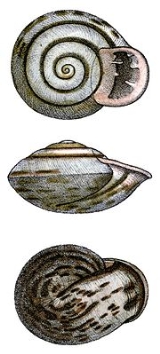
Anostoma depressum
Encyclopedia
Anostoma depressum is a species
of air-breathing land snail
, a terrestrial
pulmonate gastropod mollusk in the subfamily Bulimulinae, in the family Orthalicidae
.
Translated from French language:
"Shell suborbicular, convex on both sides, a little depressed, obtusely carinated, imperforate, glabrous; whitish with a circular reddish line above; aperture five toothed; lip strongly reflexed."
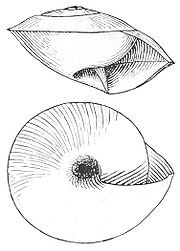 The shell
The shell
of this species is biconvex, the altitude about half the diameter, angular at the periphery, whitish, more or less brown-tinted, the base dappled with oblong spots or streaks arranged concentrically, having a dark band along the basal suture, the upper surface sparsely spotted near the periphery, and having a brown band revolving below the suture, usually with a fainter one above it. Surface is finely striate above and below, fresh specimens showing dense fine spiral lines, especially on the last whorl
. The shell is composed of 4 whorls
, that are nearly flat. The last whorl is angular or carinated at the periphery, its last half is straightened and turned upward, showing two or three grooves or pits behind the lip.
The shell aperture
is subhorizontal, semicircular, obstructed by 5 or 6 teeth. Peristome is expanded and reflexed, pinkish-brown or flesh tinted. Parietal margin is bearing two or three teeth; a minute tubercular angle-lamella is often obsolete, an erect, compressed parietal lamella, and a small infraparietal lamella at about the middle of the parietal margin. Outer margin with three (or four) folds; columellar fold usually wanting; upper and lower palatal folds well developed, the former a little larger and more oblique; suprapalatal fold tubercular, small or minute.
The width of adult shells is 31–37 mm, the height is 15-17.5 mm.
The immature shell measures 21 by 18 mm in width, the height is 10.5 mm. The axis is hollow and the mouth possesses no lamellae.
Distinguished from Anostoma octodentatum
chiefly by the narrower and
tinted lip, and fewer teeth. It is usually smaller, more angular at
the periphery, and less densely mottled beneath.
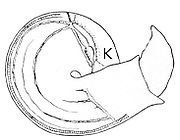 Anatomy of Anostoma depressum was examined by Harold Heath in 1914.
Anatomy of Anostoma depressum was examined by Harold Heath in 1914.
The kidney
, placed between the pericardial and body walls on the anterior face of the last fold, presents the usual sac-like appearance. Evidently the reno-pericardial opening is minute. The ureter
, likewise, is difficult to trace throughout a portion of its course. Its external opening is immediately behind that of the alimentary canal, and from this point is readily followed to the region of the pericardium
, where it decreases in caliber and passes into a network of blood vessel
s. It appears that the kidney is in contact, along its inner face, with a slender sack or tube with which the ureter communicates.
There are no special features of the digestive system of Anostoma depressum.
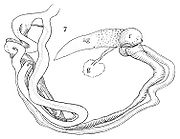
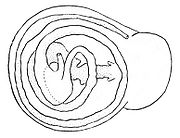 The description of the reproductive system of Ringicella ringens
The description of the reproductive system of Ringicella ringens
as described by Fischer (1869) applies in all essential details to Anostoma depressum with the exception of a penis retractor muscle attached to the vas deferens
. In Anostoma depressum the external reproductive pore, located on the right side of the head, leads into a small atrium with which the penis, hermaphroditic duct, and seminal receptacle attach. The first named is a heavy, muscular organ, accompanied by the usual slender vas deferens, their union being effected at some distance from the distal end of the penis, which thus forms a flagellum. The penis and flagellum are both sharply defined and appear to be without muscular attachments, though bound to the body wall by delicate connective tissue strands. In the neighborhood of the outer opening, however, the penis sheath affords attachment for three or four slender muscle bands that Heath inclined to regard as penis retractors. The hermaphroditic duct, a highly glandular duct of comparatively even diameter, traverses the greater portion of the first coil of the body to enter the accessory glands. All of these structures are in a quiescent condition, and in size and configuration probably fall far short of their fully developed state in the sexually mature condition. The same is likewise true of the gonad. While the duct leading to it from the accessory glands is clearly apparent throughout the first part of its course, it gradually approaches the vanishing point, and cannot with certainty be traced to a gonad, which is accordingly drawn in its hypothetical position.
Species
In biology, a species is one of the basic units of biological classification and a taxonomic rank. A species is often defined as a group of organisms capable of interbreeding and producing fertile offspring. While in many cases this definition is adequate, more precise or differing measures are...
of air-breathing land snail
Snail
Snail is a common name applied to most of the members of the molluscan class Gastropoda that have coiled shells in the adult stage. When the word is used in its most general sense, it includes sea snails, land snails and freshwater snails. The word snail without any qualifier is however more often...
, a terrestrial
Terrestrial animal
Terrestrial animals are animals that live predominantly or entirely on land , as compared with aquatic animals, which live predominantly or entirely in the water , or amphibians, which rely on a combination of aquatic and terrestrial habitats...
pulmonate gastropod mollusk in the subfamily Bulimulinae, in the family Orthalicidae
Orthalicidae
Orthalicidae are a family of tropical air-breathing land snails, terrestrial pulmonate gastropod mollusks are classified in the informal group Sigmurethra of the clade Stylommatophora...
.
Original description
Lamarck originally described Anostoma depressum under name Anostoma depressa as follows: (French description add here)Translated from French language:
"Shell suborbicular, convex on both sides, a little depressed, obtusely carinated, imperforate, glabrous; whitish with a circular reddish line above; aperture five toothed; lip strongly reflexed."
Shell description

Gastropod shell
The gastropod shell is a shell which is part of the body of a gastropod or snail, one kind of mollusc. The gastropod shell is an external skeleton or exoskeleton, which serves not only for muscle attachment, but also for protection from predators and from mechanical damage...
of this species is biconvex, the altitude about half the diameter, angular at the periphery, whitish, more or less brown-tinted, the base dappled with oblong spots or streaks arranged concentrically, having a dark band along the basal suture, the upper surface sparsely spotted near the periphery, and having a brown band revolving below the suture, usually with a fainter one above it. Surface is finely striate above and below, fresh specimens showing dense fine spiral lines, especially on the last whorl
Body whorl
Body whorl is part of the morphology of a coiled gastropod mollusk.- In gastropods :In gastropods, the body whorl, or last whorl, is the most recently-formed and largest whorl of a spiral or helical shell, terminating in the aperture...
. The shell is composed of 4 whorls
Whorl (mollusc)
A whorl is a single, complete 360° revolution or turn in the spiral growth of a mollusc shell. A spiral configuration of the shell is found in of numerous gastropods, but it is also found in shelled cephalopods including Nautilus, Spirula and the large extinct subclass of cephalopods known as the...
, that are nearly flat. The last whorl is angular or carinated at the periphery, its last half is straightened and turned upward, showing two or three grooves or pits behind the lip.
The shell aperture
Aperture (mollusc)
The aperture is an opening in certain kinds of mollusc shells: it is the main opening of the shell, where part of the body of the animal emerges for locomotion, feeding, etc....
is subhorizontal, semicircular, obstructed by 5 or 6 teeth. Peristome is expanded and reflexed, pinkish-brown or flesh tinted. Parietal margin is bearing two or three teeth; a minute tubercular angle-lamella is often obsolete, an erect, compressed parietal lamella, and a small infraparietal lamella at about the middle of the parietal margin. Outer margin with three (or four) folds; columellar fold usually wanting; upper and lower palatal folds well developed, the former a little larger and more oblique; suprapalatal fold tubercular, small or minute.
The width of adult shells is 31–37 mm, the height is 15-17.5 mm.
The immature shell measures 21 by 18 mm in width, the height is 10.5 mm. The axis is hollow and the mouth possesses no lamellae.
Distinguished from Anostoma octodentatum
Anostoma octodentatum
Anostoma octodentatum, common name Brazilian up-mouth snail, is a species of air-breathing land snail, a terrestrial pulmonate gastropod mollusk in the subfamily Bulimulinae, in the family Orthalicidae....
chiefly by the narrower and
tinted lip, and fewer teeth. It is usually smaller, more angular at
the periphery, and less densely mottled beneath.
Anatomy

The kidney
Kidney
The kidneys, organs with several functions, serve essential regulatory roles in most animals, including vertebrates and some invertebrates. They are essential in the urinary system and also serve homeostatic functions such as the regulation of electrolytes, maintenance of acid–base balance, and...
, placed between the pericardial and body walls on the anterior face of the last fold, presents the usual sac-like appearance. Evidently the reno-pericardial opening is minute. The ureter
Ureter
In human anatomy, the ureters are muscular tubes that propel urine from the kidneys to the urinary bladder. In the adult, the ureters are usually long and ~3-4 mm in diameter....
, likewise, is difficult to trace throughout a portion of its course. Its external opening is immediately behind that of the alimentary canal, and from this point is readily followed to the region of the pericardium
Pericardium
The pericardium is a double-walled sac that contains the heart and the roots of the great vessels.-Layers:...
, where it decreases in caliber and passes into a network of blood vessel
Blood vessel
The blood vessels are the part of the circulatory system that transports blood throughout the body. There are three major types of blood vessels: the arteries, which carry the blood away from the heart; the capillaries, which enable the actual exchange of water and chemicals between the blood and...
s. It appears that the kidney is in contact, along its inner face, with a slender sack or tube with which the ureter communicates.
There are no special features of the digestive system of Anostoma depressum.


Ringicella ringens
Ringicella ringens is a species of air-breathing land snail, a terrestrial pulmonate gastropod mollusk in the subfamily Bulimulinae, in the family Orthalicidae.- Distribution :This species occurs in Brazil.It lives on the ground....
as described by Fischer (1869) applies in all essential details to Anostoma depressum with the exception of a penis retractor muscle attached to the vas deferens
Vas deferens
The vas deferens , also called ductus deferens, , is part of the male anatomy of many vertebrates; they transport sperm from the epididymis in anticipation of ejaculation....
. In Anostoma depressum the external reproductive pore, located on the right side of the head, leads into a small atrium with which the penis, hermaphroditic duct, and seminal receptacle attach. The first named is a heavy, muscular organ, accompanied by the usual slender vas deferens, their union being effected at some distance from the distal end of the penis, which thus forms a flagellum. The penis and flagellum are both sharply defined and appear to be without muscular attachments, though bound to the body wall by delicate connective tissue strands. In the neighborhood of the outer opening, however, the penis sheath affords attachment for three or four slender muscle bands that Heath inclined to regard as penis retractors. The hermaphroditic duct, a highly glandular duct of comparatively even diameter, traverses the greater portion of the first coil of the body to enter the accessory glands. All of these structures are in a quiescent condition, and in size and configuration probably fall far short of their fully developed state in the sexually mature condition. The same is likewise true of the gonad. While the duct leading to it from the accessory glands is clearly apparent throughout the first part of its course, it gradually approaches the vanishing point, and cannot with certainty be traced to a gonad, which is accordingly drawn in its hypothetical position.

